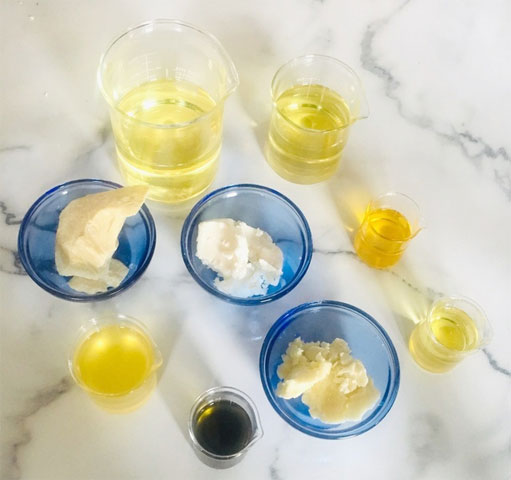
Perhaps the greatest opportunity for bath product formulating creativity is in the vast selection of available oils and butters. At Elements Bath and Body we have a wide selection of Carrier Oils and Butters available for all of your formulating needs! This guide summarizes the chemical composition, skin-feel, skin benefits, and shelf life of all of your favorite oils and butters and discusses how you can use them in lotions, body products and cold processed soap. As a general rule, you can substitute any oil for any oil or any butter for any butter in lotion, lotion bars, creams, scrubs and other body products. You can substitute any oil for any oil, any butter for any butter, any oil for any butter, or any butter for any oil in lotions made with Emulsifying Wax, NF. You cannot make substitutions in cold processed soaps, however, without running your recipe through a soap calculator, like SoapCalc because different oils and butters require different quantities of lye for saponification.
Oils and butters have varying shelf lives. It’s best to purchase smaller quantities of oils you can use in a reasonable time. In general, butters have a long shelf life (about 2 years) and oils have shorter shelf lives. Oils that are higher in monounsaturated fatty acids such as oleic acid or higher in antioxidants will have a longer shelf life. Oils that are high in polyunsaturated fatty acids such as linoleic and linolenic fatty acids have shorter shelf lives. Solid oils and butters are high in saturated fatty acids such as palmitic, stearic and lauric, and thus have a long shelf life. All oils and butters should be stored out of direct sunlight in a cooler part of the house. For oils with shorter shelf lives, consider storing them in the refrigerator or freezer. You can also add 100 ppm (about 1 mL per 10 liters of oil) of Vitamin E, an antioxidant, to help extend the shelf life of oils. If your oils or butters smell like old crayons, they have gone rancid. Throw them out! In addition to smelling gross, there is some evidence showing rancid oils can promote inflammation and acne. Not good!
You may have noticed a batch of whipped body butter or lip balm containing your favorite butter has gone grainy. This is because the different fats harden at different temperatures and form crystals. Grainy butters are not spoiled, but they are unpleasant feeling. The best way to avoid this is to gently heat your butters (a double boiler is ideal) and cool them quickly in the freezer or in an ice water bath. This allows all of the fats to solidify before they can form crystals. Keep your products away from high heat. I once left a cocoa butter lip balm in the warm car and then brought it in the house. The next day it was grainy and unpleasant feeling.
Oils and butters are mostly composed of fats, also known as tri-acyl glycerides (TAGs). TAGs are made of three fatty acid chains bonded to a molecule of glycerin through an ester linkage. A fat molecule does not usually have all three of the same fatty acid chains. Fats are nonpolar, meaning they do not mix with water. Fats are necessary components of the lipids surrounding the corneocytes, or dead cell building blocks, in the outermost layer of our skin. Fats and fatty acids make our skin waterproof and desiccation resistant. If your lipid barrier becomes damaged by wind, cold, harsh cleansers or other reasons, the skin can dry out and experience transepidermal water loss (TEWL). Dehydrated skin can look more wrinkled and feels uncomfortable. This is why oils make our skin feel so wonderful!
Most of the oils commonly used in body products and soaps are made primarily of just a few fatty acids. Linoleic acid is a polyunsaturated fatty acid and is essential to our skin and bodies. We cannot make this fatty acid ourselves and must obtain it from our diets or topical products. It is a good choice for sensitive, damaged or acne-prone skin and for restoring lipid barrier function. Oleic acid is a monounsaturated fatty acid that promotes cell regeneration and is anti-inflammatory, making it a good choice for mature skin. Stearic acid is a saturated fatty acid that softens and increases flexibility in the skin and prevents TEWL. Palmitic, lauric and myristic fatty acids offer similar skin benefits as stearic acid, though there is some evidence showing that lauric acid somewhat anti-microbial.
Of course, oils don’t just contain fatty acids. Oils and butters contain many other compounds which may have benefit to the skin. Many oils are rich sources of tocopherols and tocopheryl acetate, or Vitamin E, and important antioxidant. Oils are sources of phytosterols, too, which are sterols from plant sources. Sterols like cholesterol are essential for maintaining the lipid barrier of the skin. Many oils are rich in polyphenols including tannins and other pigments. These molecules give some oils a dry, non-greasy feel. Some polyphenols can have antioxidant, antibacterial, anti-inflammatory and and antifungal activity.
Find More Helpful Oils & Butters Info Below!
SHARE ON SOCIAL MEDIA
![]() Share this tutorial on Facebook
Share this tutorial on Facebook![]() Tweet about this tutorial
Tweet about this tutorial






